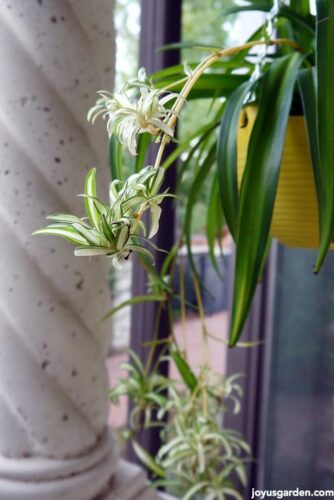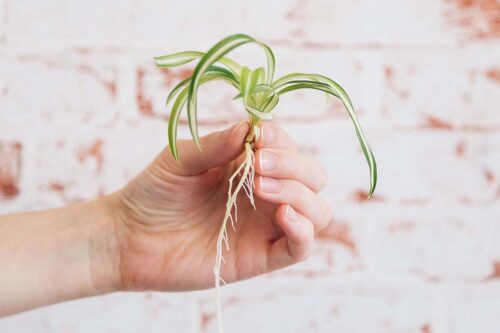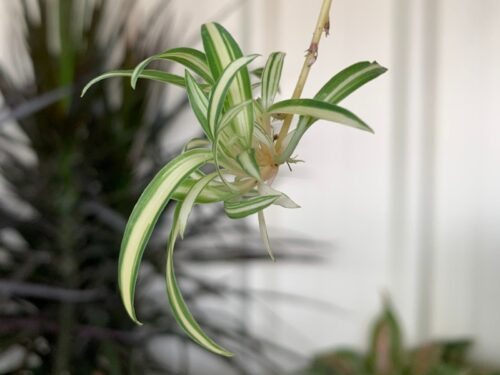Spider plants grow babies when they are mature, typically in the spring or early summer. Spider plants are known for their ability to produce plantlets, or “babies,” which grow from long, thin stems that emerge from the parent plant.
These babies can be left attached to the parent plant or propagated into new separate plants. The process of spider plant propagation is relatively easy and can be a fun way to expand your plant collection. We will explore the fascinating world of spider plant babies, including when they typically appear, how to care for them, and some tips for successful propagation.
So, let’s dive in and learn more about these charming and easy-to-grow houseplants!

Credit: www.joyusgarden.com
Life Cycle Of Spider Plants
Spider plants, scientifically known as Chlorophytum comosum, go through a fascinating life cycle that involves germination, growth, maturation, and propagation through babies. Understanding the different stages of their life cycle can help plant enthusiasts care for these resilient and adaptable houseplants.
Germination
Spider plant seeds are typically planted in well-draining soil and require warm temperatures to germinate successfully. The seeds should be lightly covered with soil and kept consistently moist. Germination usually takes place within 2-4 weeks, and the seeds sprout into tiny seedlings with long, slender leaves that resemble blades of grass.
Growth And Maturation
As spider plants grow, they develop their characteristic arching leaves and produce white flowers. The plant’s leaves can reach lengths of up to 3 feet, creating a graceful cascade of foliage. Mature spider plants can develop small plantlets, or babies, at the end of their long, arching stems. These plantlets eventually grow roots and can be propagated to create new plants.
Propagation Through Babies
Spider plant babies can be left attached to the parent plant to create a fuller, bushier appearance, or they can be carefully removed and potted individually. Once the baby plantlets have developed roots, they can be placed in a new pot with well-draining soil, where they will continue to grow and thrive independently.
Conditions For Spider Plant Reproduction
Conditions for Spider Plant Reproduction are crucial for the growth of babies. Let’s dive into some key factors you need to consider.
Sufficient Light
Spider plants require bright indirect light for optimal reproduction. Avoid direct sunlight to prevent leaf scorching.
Adequate Watering
Keep the soil lightly moist but not soggy. Overwatering can lead to root rot, impacting plant growth.
Appropriate Temperature
Maintain a temperature between 65-75°F for spider plant growth. Avoid extreme heat or cold which hinder reproduction.
Signs Of Spider Plant Propagation
Eruption of Baby Spider Plants:
Spider plants produce baby plantlets known as “spiderettes” which originate from long stems.
These miniature plants are self-propagating and abundantly emerge from the mother plant.
Root Development:
The spiderette will start developing tiny roots when placed in water or soil.
Root formation is a crucial stage as it establishes the young plant’s foundation.
Leaf Shoot Formation:
Following root growth, the baby plant develops tiny leaf shoots showcasing new growth.
These shoots are the first visible signs of the spider plant’s propagation process.

Credit: gardenerspath.com
Caring For Spider Plant Babies
Potting The Baby Spider Plants
Potting the baby spider plants is a crucial step in caring for their growth. Choose a small pot with well-draining soil and gently place the baby spider plant in it. Ensure the soil is moist but not oversaturated, and allow the plant to settle in its new environment.
Proper Watering And Fertilizing
Water the baby spider plant regularly, ensuring the soil remains damp but not waterlogged. Fertilize the plant once a month with a balanced liquid fertilizer to support its growth and health. Avoid overfeeding to prevent potential damage to the plant.
Maintaining Ideal Environmental Conditions
It is essential to maintain ideal environmental conditions for the baby spider plants to thrive. Place them in indirect sunlight to prevent scorching, and ensure the temperature is around 55-70°F. Proper air circulation and moderate humidity levels also contribute to their health and development.
Tips For Encouraging Spider Plant Propagation
Spider plants typically grow babies, or offshoots, once they have matured. These offshoots can be propagated to create new spider plants, and this can be encouraged by providing adequate light, water, and nutrients to the plant.
Pruning And Trimming
If you want to encourage spider plant propagation, one effective method is to prune and trim the plant. Pruning involves removing any dead or dying leaves, stems, or flowers. This not only improves the plant’s appearance but also allows it to redirect its energy towards producing new growth. Trimming, on the other hand, involves cutting off the long, trailing stems of the spider plant. By doing so, you can stimulate the plant to produce more babies or offsets.
Using Plant Hormones
Another way to encourage spider plant propagation is by using plant hormones. One common plant hormone used for this purpose is auxin. Auxin can be applied to the base of the spider plant where the offset or baby is forming. It helps to promote root development and encourages the baby to grow. A simple way to apply auxin is by dipping a cotton swab in a diluted hormone solution and gently rubbing it onto the area where you want the new growth to occur. Remember to use gloves and follow the instructions on the product label.
Creating A Supportive Environment
To further assist with spider plant propagation, it’s important to create a supportive environment for the plant. This includes providing the plant with adequate sunlight, water, and nutrients. Spider plants thrive in bright, indirect light, so placing them near a window or in a well-lit room is ideal. Ensure that the plant receives enough water to keep the soil slightly moist but not soggy. Overwatering can lead to root rot and inhibit the growth of babies. Finally, consider fertilizing the plant every few months to provide it with the necessary nutrients for healthy and robust growth.

Credit: www.gardeningknowhow.com
Frequently Asked Questions For When Do Spider Plants Grow Babies?
How Do I Get My Spider Plant To Produce Babies?
To encourage spider plants to produce babies, place them in bright, indirect light and keep the soil evenly moist. You can also fertilize them lightly and separate the baby plants from the mother when they have developed roots.
At What Age Do Spider Plants Have Babies?
Spider plants typically start producing babies, known as plantlets, when they are around 6 months old.
Why Does My Spider Plant Not Have Babies?
Spider plants may not have babies due to lack of light, overwatering, or inadequate nutrients. Ensure proper care for propagation.
Should I Cut The Babies Off A Spider Plant?
Yes, it’s beneficial to cut spider plant babies for propagation and to encourage growth.
Conclusion
Spider plants typically grow babies during their active growing season, which is typically in the spring and summer months. By understanding the growth cycle of spider plants, you can effectively care for and propagate these popular houseplants. Providing the right conditions and care can encourage these plants to produce healthy and thriving spider plant babies.
